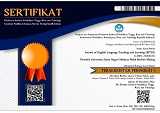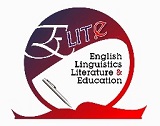Learning Outcomes of Listening Comprehension Skills through Audio Visual and Interactive-Audio
Abstract
Keywords
Full Text:
PDFReferences
Ahmad, S. R. (2016). Importance of English communication skills. International Journal of Applied Research, 2(3), 478–480.
Ampa, A. T. (2015). The implementation of interactive multimedia learning materials in teaching listening skills. English Language Teaching, 8(12), 56.https://doi.org/10.5539/elt.v8n12p56
Bowen, B. M. (1991). Look here! Visual aids in language teaching (Reprint). Macmillan.
Creswell, J. W. (2014). Research design: Qualitative, quantitative, and mixed methods approaches (4th ed). SAGE Publications.
DePorter, B., & Hernacki, M. (1992). Quantum learning: Unleashing the genius in you. Dell Publishing.
Fahyuni, E. F., & Istikomah, I. (2016). Psikologi belajar & mengajar (kunci sukses guru dalam interaksi edukatif). Nizamia Learning Center.
Farooq, U. (2014). Audio visual aids in education, definition, types & objectives.http://studylecturenotes.com/audio-visual-aids-in-education-definition-types-objectives/
Fitriyah, S. M. (2009). Pengembangan model viewing guide yang efektif sebagai media movie review pada mata kuliah listening. Jurnal Pengembangan Pendidikan, 6(2). https://jurnal.unej.ac.id/index.php/JP2/article/view/853
Guichon, N., & McLornan, S. (2008). The effects of multimodality on L2 learners: Implicationsfor CALL resource design. System, 36(1), 85–93.
https://doi.org/10.1016/j.system.2007.11.005
Herron, C. A., Hanley, J. E. B., & Cole, S. P. (1995). A comparison study of two advance organizers for introducing beginning foreign language students to video. The Modern Language Journal, 79(3), 387–395. https://doi.org/10.1111/j.1540-4781.1995.tb01116.x
Katchen, J. E., & Leung, Y. N. (1997). Can students learn English from The X-files? The Proceedings of the Fifth International Symposium in English Teaching, 243–250.
Liando, N. V., Sahetapy, R. J., & Maru, M. G. (2018). English major students’ perceptions towards watching English movies in listening and speaking skills development. Advances in Social Sciences Research Journal. https://doi.org/10.14738/assrj.56.4627
Lonergan, J. (1984). Video in language teaching. Cambridge University Press.
Markham, Paul. L., Peter, L. A., & McCarthy, T. J. (2001). The effects of native language vs.Target language captions on foreign language students’ DVD video comprehension. Foreign Language Annals, 34(5), 439–445. https://doi.org/10.1111/j.1944-9720.2001.tb02083.x
Puspita Sari, H., & Dini Sintia, A. (2021). Developing audio media for teaching listening. Konstruktivisme : Jurnal Pendidikan Dan Pembelajaran, 13(1), 37–51. https://doi.org/10.35457/konstruk.v13i1.1096
Safranj, J. (2015). Advancing listening comprehension through movies. Procedia - Social and Behavioral Sciences, 191, 169–173. https://doi.org/10.1016/j.sbspro.2015.04.513
Salazar, J. (2013). Interactive audio strategies for developing listening skills. CALICO Journal,67–75. https://doi.org/10.1558/cj.v7i1.67-75
Sempleski, S. (2003). Integrating video into the classroom curriculum. Selected Papers from Twelfth International Symposium on English Teaching.
Tomalin, B. (1994). Video, TV and radio in the English class: An introductory guide (Reprinted). Macmillan.
Tomlinson, B. (Ed.). (2013). Developing materials for language teaching (Second Edition).Bloomsbury.
Ur, P. (1984). Teaching listening comprehension. Cambridge University Press.
Yiping, J. (2016). An investigation into the effects of English movies on English listening and suggestions. International Journal of Arts and Commerce, 5(4), 47–53.
DOI: https://doi.org/10.18860/jetle.v3i2.15623
Refbacks
- There are currently no refbacks.
Jalan Gajayana 50 Malang 65144, Jawa Timur, Indonesia

This work is licensed under a Creative Commons Attribution-ShareAlike 4.0 International License.
Indexed by






